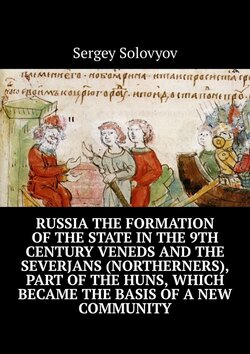Читать книгу Russia the formation of the state in the 9th century Veneds and the severjans (northerners), part of the Huns, which became the basis of a new community - Сергей Соловьёв - Страница 21
Migration of Indo-Europeans to the West, East and South
Srubnaya culture
Culture
ОглавлениеThe type of economy of the carriers of the Srubna cultural and historical community was based mainly on stall and distant pasture cattle breeding, which, among the population of the Berezhno-Mayovskaya Srubna culture, partially supplemented agriculture. In the Dnieper-Donetsk interfluve, single grains of cultivated cereals were found, which indicates the presence of floodplain agriculture in the economy of the Timber tribes. In the Ciscaucasian and Caspian steppes and semi-deserts, it is possible that semi-nomadic livestock raising was practiced. Nevertheless, the basis of the economy of the sedentary log house population of the Late Bronze Age was stall and distant cattle breeding. The priority was the breeding of cattle, a smaller percentage of the herd were horses. An important role in the economy of the population of the Srubna cultural and historical community was played by mining and metallurgical production, which was based on cuprous sandstones of the Urals (Kargalinskoe deposit) and Donetsk ridge (Bakhmutskoe deposit), ore occurrences of the Middle Volga region were also used. The basic production of metal products was predominantly located in several villages of metallurgical foundry workers – Lake Usovo (Podonechye), Mosolovka (Podonye), Lipovy Ovrag (Middle Volga region), Gorny 1 (Urals).
The tools required for metalworking are represented by axes, hammers, hammers, ore grinders, flat and grooved tesserae and chisels, “log” type cutting knives and daggers. In the late Timber period, the Timber blacksmiths master the secret of obtaining critical iron, from which the first few items are forged, mostly small in size and weak in workmanship. There are also gold jewelry.
The absence of written sources significantly complicates the solution of the issue of the ethnicity of the tribes of the Timber Cultural and historical community of the Late Bronze Age. Thus, the main method for determining ethnicity is to establish a connection between the area of the tribes of the Timber community with the spread of Indo-Iranian hydronyms and toponyms. Their pre-Scythian origin was convincingly proved by the linguist V.I. Abaev. Later, N.L. Chlenova traced the Iranian hydronyms in the steppe and forest-steppe zone from the Dnieper to the Ob, which completely coincided with the distribution area of the tribes of the Timber and Andronov cultural and historical communities and proved their belonging to the Iranian-speaking group of the Indo-European language family.
According to V.V. Napolskikh, borrowings in the Finno-Ugric languages indicate that the carriers of the Bronze Age steppe cultures spoke the language of the Indo-Aryan type. Such attribution, as evidenced by the phonetics of borrowings, has traditionally been rejected for historical reasons. The Eastern Iranian speech spread in the steppe only with the culture of roller ceramics at the end of the 2nd millennium BC. e. The bearers of the Srubna culture chronologically preceded the Scythians and Cimmerians. For this reason, the Srubnaya culture is often regarded as an archaeological analogue of the first Iranian dialects of the Northern Black Sea region. In other words, the carriers of culture are the predecessors of the Scythians and their kindred peoples. However, there is another point of view: the area of the Srubnaya culture is a bridgehead from which the migration of ancient Iranians to the northwest of modern Iran took place. According to this point of view, the semi-nomadic cattle-breeding tribes of the Timber and Andronovo cultural and historical communities represent the Iranian group of the Indo-European language family at an early stage of its development.The early and middle phases of the Late Bronze Age in Eastern Europe coincide with favorable climatic conditions – mainly humid and warm weather. There is a sharp rise in the productive forms of the economy. Accordingly, in the XVIII – XIII centuries BC, the maximum population density of all regions of the Eastern European steppe and forest-steppe is observed. The Srubna cultural and historical community is born, which was destined to complete the tradition of the formation of great ethnocultural associations in Eastern Europe in the Bronze Age. The demographic explosion in the environment of the Timber Community, which peaked in the forest-steppe in the 16th-15th centuries BC, and in the steppe in the XIV – XIII centuries BC, led to the depletion of natural resources and the collapse of the Timber-Cultural and Historical Community. Aridization (drying out) of the climate at the end of the Bronze Age (XI – VIII centuries BC) led to the degradation and disappearance of the Timber culture.
The change in climatic conditions for dry and cool weather, together with total overpopulation, led to disastrous consequences. The population is sharply decreasing, which according to archaeological data is recorded in a decrease in the number of settlements and their cultural transformation. The bearers of the Srubna cultural and historical community took a direct part in the formation of the Belozersk and Bondarikha cultures of the final stage of the Bronze Age and had a noticeable impact on the population of the forest belt of Eastern Europe in the form of the Pozdnyakovsk and Prikazan cultures.
Pozdnyakovskaya culture, swastika pattern, State Historical Museum
